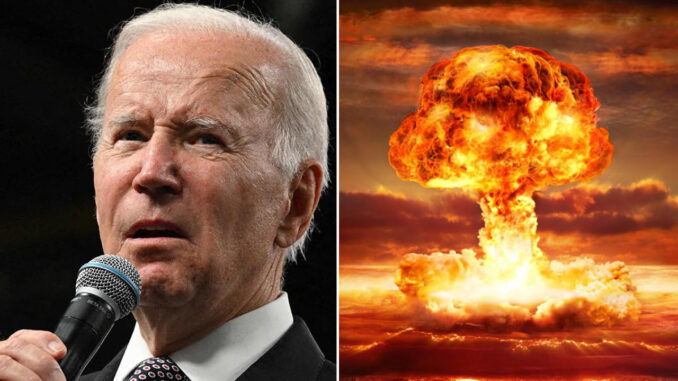
Last year President Biden deaclred that global temperature rising more than 1.5 degrees Celsius in the next two decades is more frightening than a nuclear war.
“The only existential threat humanity faces even more frightening than a nuclear war is global warming going above 1.5 degrees in the next 10 to 20 years,” Biden said .

BYPASS THE CENSORS
Sign up to get unfiltered news delivered straight to your inbox.
You can unsubscribe any time. By subscribing you agree to our Terms of Use
Latest Video
He also warned: “That’d be real trouble. There’s no way back from that”
Donald Trump disagrees….he says “the biggest problem we have in the whole world, it’s not global warming. It’s nuclear warming”.
The Daily Sceptic reports: In an article for the Washington Post‘s Philip Bump looks at the evidence…
In an effort to resolve this debate, Bump contacted the Centre for the Study of Existential Risk at the University of Cambridge. And one S.J. Beard – described on the centre’s website as an “emerging research leader in the transdisciplinary field of Existential Risk Studies” – told him that the best place to start is by defining what we mean by “existential”. “We tend to look at two things,” Beard said. “One of them is full-on human extinction. The other is global societal collapse.”
So with those criteria, whose existential threat does Beard view as the bigger risk: Trump’s or Biden’s? According to Bump:
“The problem is they’re just incredibly different kinds of risk,” Beard began, fairly. The difference, though, is mainly one of timelines. The damage done by climate change accrues slowly, chronically. It’s accruing now, as Beard noted. The threat of nuclear weapons is, to put it dryly, acute. In each case, there would be risks to food supplies, forced relocations, interruptions to power production and so on. It’s just that it happens very rapidly in the wake of a nuclear exchange.
“Right now, nuclear weapons are much more likely to have really global catastrophic effects than climate change,” Beard said. “But in 100 years’ time, the effects of climate change may have added up to what we would experience with a nuclear war.” …
Asked which existential threat seemed more likely to unfold, Beard demurred.
So with no firm reply I visited Mr. Beard’s organisation’s website and discovered under ‘Research’ there was no report on the risk of nuclear holocaust, but there was an extensive section on climate change that relied almost completely on the research of the economists Wagner and Weitzman, who used the IPCC’s figures to produce estimates – which were of course highly uncertain – of possible extreme temperature rises. “If we continue to pursue a medium-high emissions pathway, [the IPCC authors] estimate the probability of eventual warming of 6°C is around 10%, and of 10°C is around 3%.”
What this completely misses, however, is that at COP 28 last year, the IPCC announced that it had slashed its estimate for the Earth’s maximum warming in half, from 5-6°C. to only 2.7°C.
It’s also important to note that warming due to an increased concentration of CO2 is logarithmic. This means that as the concentration of CO2 increases the amount of warming wanes until it levels off completely and rises no further. Therefore, the risk of the Earth reaching any ‘tipping point’ for a climate catastrophe to happen is small to non-existent. Alarmist scientists claim that the modest effect of carbon dioxide will trigger other processes that cause runaway warming and ‘climate breakdown’. But this is all just guesswork of course as no such tipping point has been observed.
So, what has been the record of ‘climate related deaths’ so far?
Over the past 100 years the number of deaths from catastrophic climate events has declined by 99%.
Also, since 1988 the Earth’s warming climate has so far only resulted in a greening planet, with shrinking deserts and rising temperatures that are saving thousands of people worldwide every year from premature death. These lives saved far outweigh the deaths that have been attributed to climate change worldwide.
According to the UN, droughts over the last 50 years have averaged 13,000 deaths annually, a number that has not been increasing.
NASA’s satellite observations found that since 2003 that the number of wildfires has declined. Deaths due to wildfires have typically been extremely low. Globally, wildfires were responsible for the death of approximately 310 people from January to September 2023, making it the year with the highest number of such deaths since 1990. Over the past three decades, the global death toll due to wildfires has totalled around 2,900.
The number of famines worldwide has been in sharp decline since the 1960s.
According to NASA’s satellite data, sea levels have risen only 100.1 mm since 1993. This has come to just 4 inches over the past 30 years. And the most recent scientific research using satellite data has demonstrated that about 50% of the sea level increase on the U.S. East Coast has been attributable to subsidence and not thermal expansion of the oceans or melting glaciers and ice caps.
A new report by Allan Astrup Jensen, Research Director and CEO at the Nordic Institute of Product Sustainability and Environmental Chemistry and Toxicology in Denmark, shows that from September 2007 through September 2023, Arctic sea ice declines were near zero.


